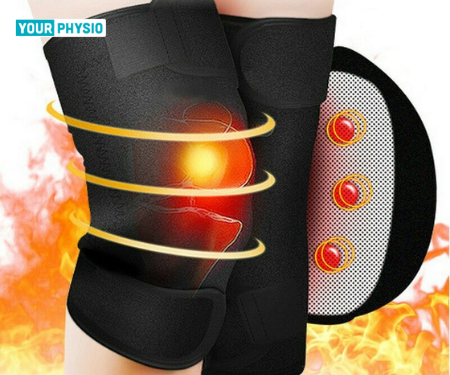Having knee pain is very common globally. It normally occurs due to arthritis, inflammation, or weak bones. Mostly affecting older age when muscles become weak. It is seen more commonly in females than males.
The pain can be associated with the joint or the muscles or the ligaments. The patella or kneecap is also a common site of pain.
The cause behind knee pain can be many. It usually presents as a range of signs. Like trouble during stair climbing, walking, or squatting. Swelling, redness, and a pop sound are other common signs.
Heat treatment to any body part can be given in many ways. Applying a heating pad, or a heat belt is most commonly adopted. Whereas, a hot towel or cushion might even work the same wonders.
An orthopaedic or a physiotherapist can diagnose the root cause of knee pain by looking at the condition’s symptoms and signs.
The most widely used treatment approach for knee pain is a hot pack/bag. The numerous benefits of a hot pack are what make it the first choice for therapists before exercise.
How does a hot pack function?
A hot pack is the best way to reduce knee pain without medications. Using a moist or hot pack is perhaps the most common approach to reducing pain. It assists with relaxing joints, at last, reducing pain too.
Muscle catch, joint pain, and stiffness can restrict movement. It can even prevent the person from doing his daily tasks. Applying a heat pack to the joint widens the blood vessels. This permits more blood, oxygen, and nutrients to heal the impacted joint. Because of this, the blood turns out to be better, leading to improved muscle flexibility. Finally, faster and holistic healing.
This sort of treatment is nothing new. Hot pack usage dates back to the Greeks and Egyptians who used the sun's beams as treatment.
Today, however, we do not need to do so. Hot pads/bags/cushions have made it more convenient and easy for us.
Types of hot packs:
1. Regular gel packs
Regular gel cushions have various kinds of gel in them. These gels can store more heat than water. There are infrared knee warming cushions.
2. Electric or heat pad
Using An electric heat pad is quicker than a gel hot pack and is more convenient to use. The electric ones can be utilised from any place in your home. For example, lying in bed or sitting on a seat.
Advantages of heat treatment
Decreases pain rapidly
Heals affected tissues
Widens blood vessels
Releases tension from the muscles
Reduces swelling
Assists with detoxifying the body
Reduce joint stiffness. Warmth builds the flexibility of the muscles and connective tissue, which expands joint flexibility and reduces joint stiffness.
Distracts the mind from the pain. By working on the pain cycle.
Even though hot packs for the knee might appear to be incredibly advantageous. They should not be used without talking to your doctor. Heat treatment is a simple, economical, and prescription-free method for reducing pain and discomfort.
There are no hard or quick standards in regards to utilising a warming cushion on your knee. Everything relies upon the degree of pain and your resilience to warmth. However, an estimated 15 to 30 minutes can be the ideal timeframe.
On a low setting, you can utilise the warming cushion for a more extended period, perhaps as long as 60 minutes.
Precautions while using a heat treatment
Try not to put the heat belt or warmed gel pack directly on your skin. Wrap it with a towel before applying it to the skin. This prevents the skin from burning.
Try not to doze off while using a hot pack/belt.
Begin at the lowest level and gradually increase the heat while using a hot pack.
Avoid using a hot pack with broken wires or torn ends.
Try not to apply a hot cushion to injured or infected skin.
How to make a hot pack treatment method at home?
In case you don't have a hot pack, you can make your own using things currently in your home.
You would need an old cotton sock, rice, a sewing machine, or a needle and string.
Fill the old sock with rice.
Then, put the sock in the microwave for around 3 to 5 minutes. Or keep it in boiling water for 4 minutes.
When the microwave stops, cautiously take off the sock and keep it on your knee. 5.
Assuming that the sock is too hot, let it cool or enclose it with a fabric.
When to use a hot and when to use a cold pack?
Not all types of pain can be healed with a hot pack. A thorough examination by a specialist is very important here. The doctor or physiotherapist will assess your pain. The type of pain, location, aggravating and relieving factors are assessed.
Hot pack is used to relieve pain that has been present for some time such as chronic pain and joint stiffness. These symptoms are usually seen in chronic conditions like arthritis, osteoporosis, back problems, etc.
On the other hand, a cold pack is used to reduce swelling. It is commonly used in immediate or recent injuries. Sports injuries, muscle injuries, ligament tears require cold packs. It slows down the blood supply to the area, hence reducing swelling. A reduction in the swelling reduces pain too.
Ideally, cold packs should be used in the first 24 to 48 hours of injury. This is majorly done to prevent further damage. Whereas, a hot pack should be used to promote the healing of tissues.

Illustrations designed by freepik